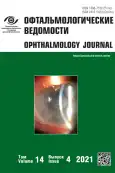Pellucid marginal degeneration classification development based on investigation of relationship between functional and refractive changes
- Authors: Vasilieva I.V.1, Kostenev S.V.1, Vasiliev A.V.1
-
Affiliations:
- S.N. Fedorov Eye Microsurgery Federal State Institution
- Issue: Vol 14, No 4 (2021)
- Pages: 19-26
- Section: Original study articles
- URL: https://journals.rcsi.science/ov/article/view/79626
- DOI: https://doi.org/10.17816/OV79626
- ID: 79626
Cite item
Abstract
BACKGROUND: One of the problems in the diagnosis and treatment of pellucid marginal degeneration of the cornea is the difficulty of systematizing its manifestations due to the lack of classification. This is due to the low frequency of pellucid marginal degeneration in the structure of primary keratectasia, the main type of which is keratoconus. The developed classifications of keratoconus cannot be fully applied to pellucid marginal degeneration.
AIM: The aim was to develop a classification of pellucid marginal degeneration based on investigation of relationship between functional and refractive changes.
MATERIALS AND METHODS: The study included 42 people (42 eyes) with pellucid marginal degeneration. Keratometry and refractometry were performed, uncorrected and best corrected visual acuity, as well as cylindrical and spherical components of subjective refraction were studied, and retinal visual acuity was determined. The 1st group – 12 patients (12 eyes) with fully corrected induced ametropia (best corrected visual acuity ≥0.8), the 2nd group – 17 patients (17 eyes) with partially corrected induced ametropia (<0.8 and ≥0.3), the 3rd group – 13 patients (13 eyes) with uncorrected induced ametropia (<0.3).
RESULTS: To develop a clinical classification of pellucid marginal degeneration by stages, we selected: the values of corneal astigmatism, best corrected visual acuity and Index of difference between the values of maximum and minimum keratometry (ΔK), all of which had good separation of obtained data, and their demarcate values in groups.
CONCLUSION: The study showed the presence of relationship between functional and refractive changes indices of eyes with pellucid marginal degeneration. The leading parameters of refractive status, objectively determining the value of best corrected visual acuity, are induced corneal astigmatism and ΔK. The developed classification of pellucid marginal degeneration is easy to use and makes it possible to determine the stage of keratectasia even if there is only induced corneal astigmatism or ΔK values.
Full Text
##article.viewOnOriginalSite##About the authors
Irina V. Vasilieva
S.N. Fedorov Eye Microsurgery Federal State Institution
Author for correspondence.
Email: naukakhvmntk@mail.ru
ORCID iD: 0000-0002-8226-1292
SPIN-code: 5921-0214
ResearcherId: AAK-8884-2021
Ophthalmologist of Highest Qualification
Russian Federation, 211, Tikhookeanskaya st., Khabarovsk, 680033Sergey V. Kostenev
S.N. Fedorov Eye Microsurgery Federal State Institution
Email: naukakhvmntk@mail.ru
ORCID iD: 0000-0002-7387-7669
SPIN-code: 1813-0938
Scopus Author ID: 56034394400
ResearcherId: F-9091-2017
Dr. Sci. (Med.), Senior Researcher Director
Russian Federation, MoscowAlexey V. Vasiliev
S.N. Fedorov Eye Microsurgery Federal State Institution
Email: naukakhvmntk@mail.ru
ORCID iD: 0000-0001-9712-0276
SPIN-code: 5780-0798
ResearcherId: AAK-7971-2021
Cand. Sci. (Med.), MD, Ophtalmologist of Highest Qualification, Chief of Cataract Surgery Department
Russian Federation, 211, Tikhookeanskaya st., Khabarovsk, 680033References
- Tsokolas G. Pellucid Marginal Degeneration (PMD): A Systematic Review. J Clin Ophthalmol Eye Disord. 2020;4(1):1031.
- Vasilieva IV, Kostenev SV, Egorov VV, Vasiliev AV. Study of clinical, statistical, anatomical, optical and functional properties of primary keratoectasia in patients living in the Far Eastern Federal District of Russia. Fyodorov Journal of Ophthalmic Surgery. 2020;(4):30–35. (In Russ.) doi: 10.25276/0235-4160-2020-4-30-35
- Salomão MQ, Hofling-Lima AL, Gomes Esporcatte LP, et al. Ectatic diseases. Exp Eye Res. 2021;202:108347. doi: 10.1016/j.exer.2020.108347
- Bikbov MM, Bikbova GM. Ehktazii rogovitsy. Moscow: Oftal’mologiya, 2011. 164 p. (In Russ.)
- Slonimskiy AYu, Slonimskiy YuB, Sitnik HV, et al. Pellucid Marginal Corneal Degeneration and Keratoconus: Differential Diagnosis and Management of Patients. Ophthalmology in Russia. 2019;16(4): 433–442. (In Russ.) doi: 10.18008/1816-5095-2019-4-433-441
- Raizada K, Sridhar MS. Nomogram for spherical RGP contact lens fitting in patients with pellucid marginal corneal degeneration (PMCD). Eye Contact Lens. 2003;29(3):168–172. doi: 10.1097/01.ICL.0000072828.14773.3F
- Martínez-Abad A, Piñero DP. Pellucid marginal degeneration: Detection, discrimination from other corneal ectatic disorders and progression. Cont Lens Anterior Eye. 2019;42(4):341–349. doi: 10.1016/j.clae.2018.11.010
- Koc M, Tekin K, Inanc M, et al. Crab claw pattern on corneal topography: pellucid marginal degeneration or inferior keratoconus? Eye (Lond). 2018;32(1):11–18. doi: 10.1038/eye.2017.198
- Gomes JA, Tan D, Rapuano CJ, et al. Global consensus on keratoconus and ectatic diseases. Cornea. 2015;34(4):359–369. doi: 10.1097/ICO.0000000000000408
- Amsler M. Some data on the problem of keratoconus. Bull Soc Belge Ophtalmol. 1961;129:331–354.
- Krumeich J, Daniel J, Knulle A. Live-epikeratophakia for keratoconus. J Cataract Refract Surg. 1998;24(4):456–463. doi: 10.1016/s0886-3350(98)80284-8
- Bogan SJ, Waring GO, Ibrahim O, et al. Classification of normal corneal topography based on computer-assisted videokeratography. Arch Ophthalmol. 1990;108(7):945–949. doi: 10.1001/archopht.1990.01070090047037
- Abugova TD. Clinical classifications of primary keratoconus. Sovremennaja optometrija. 2010;(5):17–20. (In Russ.)
- Li X, Yang H, Rabinowitz YS. Keratoconus: classification scheme based on videokeratography and clinical signs. J Cataract Refract Surg. 2009;35(9):1597–603. doi: 10.1016/j.jcrs.2009.03.050
- Izmailova SB, Malyugin BEh. Novaya khirurgicheskaya klassifikatsiya keratehktazii razlichnogo geneza. Proceedings of the X Congress of Ophthalmologists of Russia. Moscow: Oftal’mologiya, 2015. P. 186–187. (In Russ.)
- Titarenko ZD. O klassifikatsii keratokonusa. Journal of ophthalmology (Ukraine). 1982;(3):169–171. (In Russ.)
- Bikbov MM, Khalimov AR, Surkova VK, Usubov EL. Results of corneal crosslinking for pellucid marginal corneal degeneration. Vestnik Oftalmologii. 2017;133(3):58–66. (In Russ.) doi: 10.17116/oftalma2017133358-64
Supplementary files



















